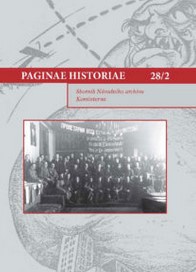KOMUNISTICKÁ STRANA ČESKOSLOVENSKA NA LIBERECKU MEZI LETY 1921–1935
THE COMMUNIST PARTY OF CZECHOSLOVAKIA IN LIBEREC REGION IN 1921–1935
Author(s): Jakub VrbaSubject(s): Local History / Microhistory, Political history, Government/Political systems, Interwar Period (1920 - 1939), History of Communism
Published by: Národní archiv
Keywords: Communist Party of Czechoslovakia (KSČ); Liberec Region; 1921-1935; local history and politics;
Summary/Abstract: The paper focuses on the story of the Communist Party of Czechoslovakia (KSČ) in Liberec Region between 1921 and 1935. This region was inhabited at the time mostly by German speaking population and belonged to the most important bastions of the KSČ in the whole country. The Liberec Region was the second most numerous regional organisation and, in some areas, the party candidates received to one third of all votes cast during 1920s elections. The paper presents, in its first part, circumstances of the Communist party establishment, since the party was founded in Liberec earlier than in Prague, then it sketches basic characteristics of the Liberec KSČ including its adjacent organizations such as unions, consuming cooperative, printing house, or other leisure time associations. The text reconstructs the way the party mobilised its supporters during 1920s in the region. It succeeded not only by blaming external enemies such as the state, local businessmen or social democrats, but also internal enemies that the party needed to get rid of. The crucial role was played also by the material and cultural support provided by above mentioned adjacent organisations. The final part of the paper analyses the causes that led to a major drop in sup-port of the party throughout the region. Although there were undoubtedly several contributing factors, it shows that the key moment was the adoption of the Comin-tern policy and rise to power of the younger generation of party officials headed by Klement Gottwald in 1929. A subsequent internal crisis in the regional centre lasted longer than in Prague and was followed by a massive walkout of members linked to financial difficulties that struck also the adjacent organisations. Especially in the time of the economic depression and the rise of Sudeten German Party, the Communist were strongly limited in their ability to address their sympathisers and to support them both in material and cultural way.
Journal: Paginae Historiae
- Issue Year: 28/2020
- Issue No: 2
- Page Range: 162-180
- Page Count: 19
- Language: Czech

